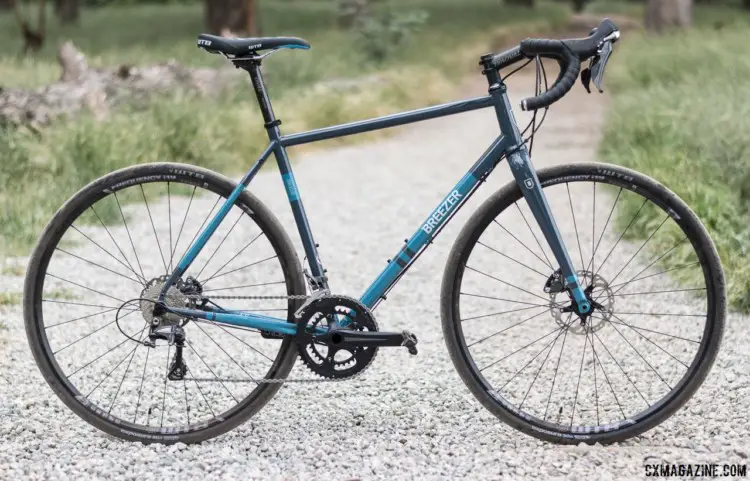Frame builder Joe Breeze is prominent in the Mountain Bike Hall of Fame and acknowledged as one of the fathers of mountain biking for his numerous contributions to the sport, not the least being the development of the first successful modern mountain bike. He is still active in cycling as he continues to innovate, contribute and advocate for bicycling.
Breeze sold the Breezer brand to ASI, parent company of Fuji bikes, in 2008, but the company still gives development power to Breeze, who is still hard at work with innovations in bikes for transportation, mountain biking and now (once again) the road.
We first saw the Breezer Inversion in 2016 at the Sea Otter Classic as a prototype and then as a production model at the Sea Otter Classic earlier this year. Now with the production bike in hand, we have a long-term ride review.
The Frame
When we previously spotlighted the Inversion, we noted Breeze prefers to use non-heat-treated steel because it's easier to work with during frame building. The frame is then heat treated after the build. This process is challenging because the builder needs to predict frame warpage during heat treatment, since the cold setting is then much harder. Despite the challenges, Breeze likes the integrity and ride quality of the frame that comes from this approach.
The Inversion has a conical tapered head tube that is CNC-machined and a 34.9mm diameter downtube. Both rack and fender mounts are nicely present with the fender mounts hidden on the Breezer-designed 12mm thru-axle fork ends. Breeze pioneered a rear dropout style that many custom builders use today, and he designed new Breezer 12mm thru-axle rear ends for this project. The frame houses three bottle mounts and a BB92 has been selected to offer a wide stance for the chainstays without the need to bow them radically.
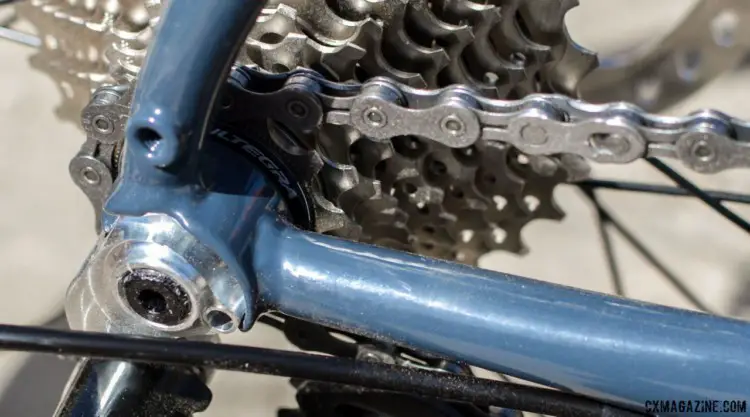
The Inversion uses custom Breezer dropouts for a 12mm thru-axle. Breezer Inversion gravel / cyclocross bike. © C. Lee / Cyclocross Magazine
The rear caliper is post mount, located between the seat and chainstays with each tube sharing the load of brake force. Mark Vanek, product manager for ASI and Breezer, told Cyclocross Magazine this is because style-centric flat mounts require reinforcement of the tube ends by either increasing the tube gauge or diameter or using a pre-formed endpiece, all which add weight and alter ride quality.
We can confirm the geometry includes a road bike-like 7.5cm bottom bracket drop combined with cyclocross-standard 42.5cm chainstays. Our Large test frame has a bit of a long front center with the 57cm effective top tube and 72-degree head tube angle. The result is a 103.6cm wheelbase and minimal toe overlap. With a 54cm seat tube length set at 73 degrees, and a 155mm headtube, the standover is about 782mm. The reach is 387mm and the stack is 590mm.
The Build
Our size Large model was equipped with a full Shimano Ultegra 6800 drivetrain and hydraulic RS-685 brakes. The bike is set up for post mount rear brakes, but the 12mm thru-axle carbon fork uses a flat mount caliper. The crankset is a Praxis Works hollow-forged compact with double 50-34 chainrings that is paired with an 11-28 11-speed cassette, suggesting more of a road than off-road appeal.
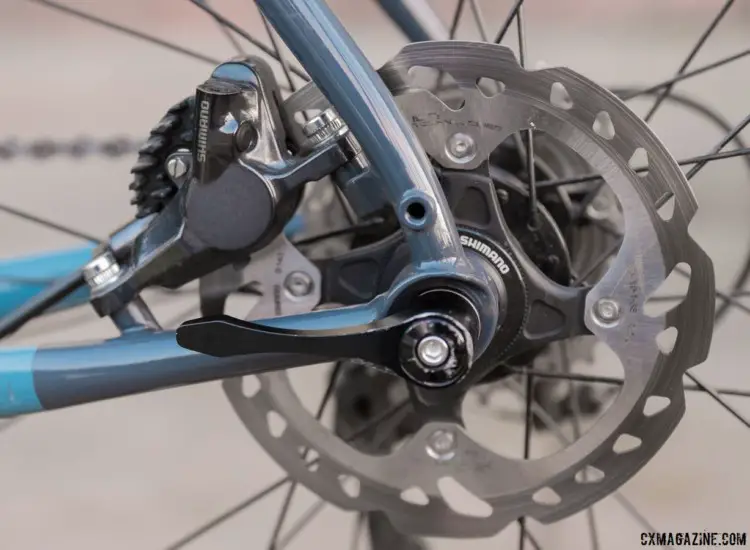
The seatstays and chainstays share the brake caliper load for the post mount setup. A 140mm rotor is the default rotor size. Breezer Inversion gravel / cyclocross bike. © C. Lee / Cyclocross Magazine
Other components, including the handlebars, stem and seat post are Oval Concepts and ASI-owned brands, the latter being a carbon model for the 27.2 mm diameter. We appreciated the true two-bolt design of the seat post, both for adjustment and also because it provides security against slipping, which is something we have experienced with other clamp designs.
The post is topped with a WTB Volt saddle with cro-mo rails. The alloy bar deserves special mention as it’s 44cm wide at the brake hoods, 12.5cm shallow and flares considerably at the bottom to 54cm (C-C measurements).
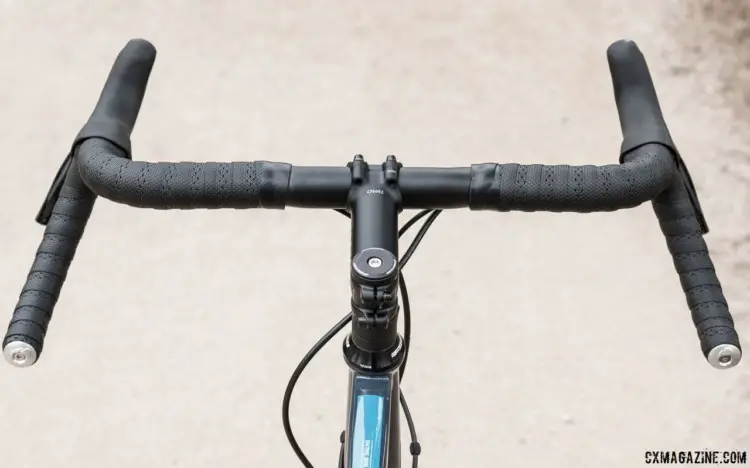
The Inversion comes with 44cm-wide flared handlebars. Breezer Inversion gravel / cyclocross bike. © C. Lee / Cyclocross Magazine
The wheelset uses WTB Frequency i19 rims with 28 double-butted spokes laced 2X to Formula 12mm thru-axle disc hubs. WTB Exposure TCS 30mm tires came on the rims with tubes installed. The new spec for the 2018 model is slightly wider WTB Frequency i23 rims laced with 32 2X double butted spokes to Formula disc hubs with 6-bolt IS rotor mounts. WTB Exposure 32 TCS tires will come on the new bike.
The Ride
In this new category of bikes for all surfaces, there are those that are off-road-oriented and those that are decidedly road-oriented. The Breezer Inversion is indeed the latter. Vanek told me that Joe Breeze designed the bike to be the road bike for the mountain biker. The geometry, included tires and gearing are certainly a combination of cyclocross and road bike, but the flared drop bars pay homage to some old mountain bikes.
I have had the opportunity to review the Inversion alongside the Ritchey Outback (reviewed here), both of which are aimed at similar riders. Both these steel bikes are designed by former collaborators during the infancy of mountain bike development and both builders are Mountain Bike Hall of Fame inductees.
However, different approaches are taken with bikes in this category. Tom Ritchey leans slightly more off-road and Joe Breeze slightly toward the pavement. The two bikes have different design features and personalities, just like their designers.
The Breezer Inversion is a great road bike. It is stable and predictable even if the pavement is not. It carves road turns so confidently I could close my eyes and just lean the bike in. In bumpy turns, the bike soaked up the uneven surface and the Inversion, with its long, low road geometry, carried me through the turns.
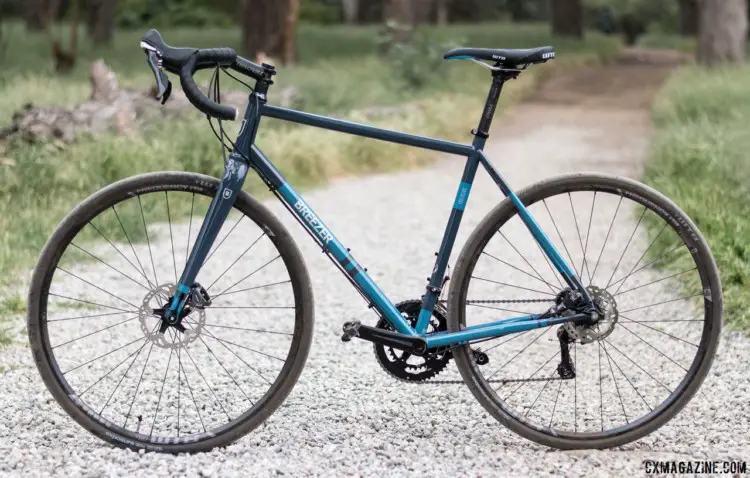
The Inversion has a long, low geometry that makes it responsive on the road. Breezer Inversion gravel / cyclocross bike. © C. Lee / Cyclocross Magazine
The Inversion is long for a road bike and low for a ’cross bike, essentially a touring bike from the old days and actually similar to my 1964 Schwinn Paramount racing bike. That said, the Inversion handles better than my vintage Schwinn or touring bikes of the past. It’s lighter, livelier and seemingly more nimble. Of course, the level of control with the Shimano drivetrain and hydraulic brakes is second to none.
The WTB wheel and tires produce a surefire tubeless combination, so I taped the rims and mounted the 30mm Exposure tires tubeless. The result was a ride that felt significantly smoother than when I had tubes installed. Losing 200 grams of rotating weight made a huge difference in the ride quality. I could also more confidently drop the tire pressure and take the smooth tires off-road with more comfort and handling confidence.
Perhaps fittingly as a Cyclocross Magazine reviewer, taking smooth treads off-road is not my thing. I don't mind a bit of drift, but sliding out and losing traction on steep sections of dirt reduces the fun factor for me, so I swapped in 33mm tubeless cyclocross tires. Not much more width, but certainly more tread.
I took the bike on cyclocross courses where it felt familiar, as if I’d raced it for years. That is until I rode over bigger obstacles, then the low bottom bracket and large chainring made themselves known with more frequent pedal strikes and some chainring bite.
Handling in chicanes among the trees was fun thanks to the low bottom bracket, although the ability to pedal through was more limited. The longish back end tracked well and in straight, rough sections, maybe added to the comfort and stability. At the same time, the length in the back could make it more difficult to maintain traction in the steepest loose sections.
With the chainstays and front center as it is, the bike is well balanced, and for that reason, you can stand on a dirt climb and not lose rear traction nor have front-end wander, but when the going gets really steep, you have to lean forward to keep the front end on, which can cause the rear to slip. Even with narrower tires, the Inversion damps and absorbs a lot of the impact load, like higher-end steel bikes are known to do.
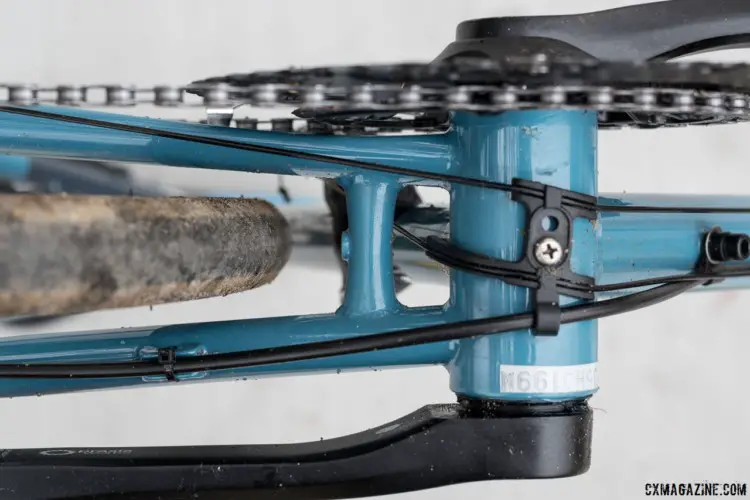
There is decent clearance around the 33mm WTB Exposure tires, with room for 40mm+ tires. Breezer Inversion gravel / cyclocross bike. © C. Lee / Cyclocross Magazine
Off-road, the bike really shines when mounted with 38 or 40mm tires. The bike gains a half centimeter of elevation for the bottom bracket. Forty mm is the absolute maximum tire width for the rear, and in that case, you have to watch the size of any side knobs.
A quirk with 38-40mm tires is the long arm of the Ultegra 6800 front derailleur may rub when you shift to the large chainring, which brings the front derailleur arm in and down. The arm may just clear but the cable end will rub. The big upside is you gain traction, float and ground clearance with bigger tires. That is testament to the bike's versatility, with a mere change in tires, it changes its personality.
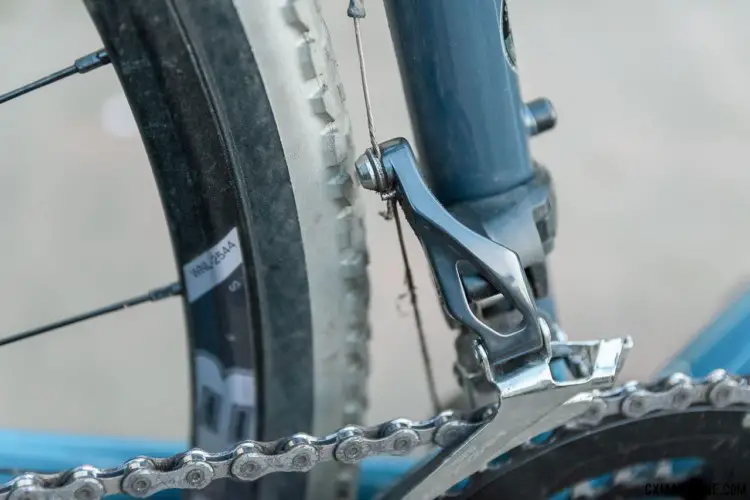
The long swing arm of the Shimano Ultegra 6800 front derailleur almost touches the 33mm cyclocross tire. A wider tire rubs. New, redesigned Shimano front derailleurs will solve this issue. Breezer Inversion gravel / cyclocross bike. © C. Lee / Cyclocross Magazine
In theory, all bikes are like that, but the Inversion handles each change with aplomb, as if it was specifically designed for that new setup. With the hidden eyelets for fenders, it can also become an all-weather adventure bike and with the rack mounts, you can press the Inversion into commuting, touring or bikepacking.
The quality of the Breezer Inversion’s ride is at its core of engineered steel with the subtle construction nuances from heat-treated alloy, shaped tubes and joining method. Ask any builder, and they will say each element contributes, and Joe Breeze combined his decades of experience building different styles of bikes to create the Inversion.
The Verdict
Steel all-around bikes tend to have either a more road or off-road appeal. Although the Breezer Inversion is closer to a road bike with both its long, low geometry and choice of gearing, it still performed well on varied terrain. On the road, the geometry helped absorb some of the impact when surfaces got sketchy while still providing smooth handling through corners.
Off the road when equipped with fatter, knobby tires, the Inversion still provided a fun, nimble ride, even if the low bottom bracket did cause the occasional pedal strikes and chain ring bite.
Perhaps the most defining characteristic of the Inversion is its ability to change roles like an Oscar-winning actress or actor. Whatever the desired setup, with a change of tires or the addition of a rack, the Breezer quickly adapted to the new desired use with little compromise in performance.
The Inversion is a steel bike at heart, so weight weenies need not apply, and riders need to understand its personality with the low bottom bracket and longish chainstays. But if they are accepting of what the Breezer can do, it is a fun-to-ride bike that is ready for adventure, whatever the surface of the day might be.
MSRP: $2500 as tested
Frame: JEF heat-treated steel alloy, hydroformed, TIG welded
Fork: Breezer carbon 12mm TA
Weight: 21.2 pounds, 13.9 pounds without wheels
Shifters: Shimano RS-685
Derailleurs: Shimano Ultegra 6800 front, and rear GS medium cage.
Crankset: Praxis Works Zayante 50-34
Brakes: Shimano RS-685
Cockpit: 3T alloy stem and bar
Seatpost: Oval Concepts 850 carbon
Saddle: WTB Volt cro-mo
Wheels: WTB Frequency i19 (i23 spec for 2018), Formula hubs
Tires: WTB Exposure 30 (Exposure 32 spec for 2018)
Warranty: lifetime, frame and fork
Country of origin: Taiwan
More info: breezerbikes.com













